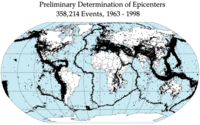
Photo from wikipedia
Modeling of tsunami waves generated by subaerial landslides is important to provide accurate hazard and risk assessments in coastal areas. We perform small-scale laboratory experiments where a tsunami-like wave is… Click to show full abstract
Modeling of tsunami waves generated by subaerial landslides is important to provide accurate hazard and risk assessments in coastal areas. We perform small-scale laboratory experiments where a tsunami-like wave is generated by the gravity-driven collapse of a subaerial granular column into water. We show that the maximal amplitude reached near-shore by the generated wave in our experiments is linked to the instantaneous immersed volume of grains and to the ultimate immersed deposit. Despite the differences in scale and geometry between our small-scale experiments and the larger-scale geophysical events, a rather good agreement is found between the experimental law and the field data. This approach offers an easy way to estimate the amplitude of paleo-tsunamis.
Journal Title: Scientific Reports
Year Published: 2021
Link to full text (if available)
Share on Social Media: Sign Up to like & get
recommendations!